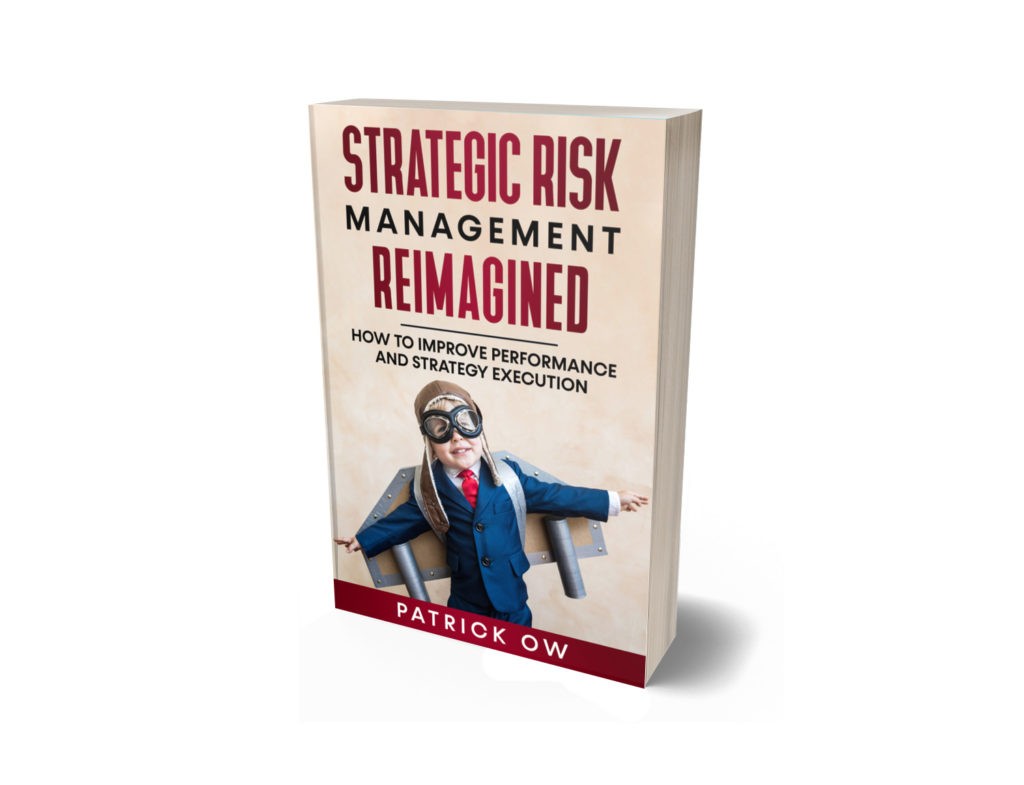Strategic Risk Management Reimagined: How to Improve Performance and Strategy Execution

In this incredibly in-depth handbook, Patrick Ow (of PracticalRiskTraining.com) gives an amazing amount of how-to detail on pretty much everything corporate executives need to know to succeed and maximize their organizational performance by identifying, quantifying, and mitigating strategic risks that affect their corporate strategy, strategic objectives, and strategy execution.
Winston Churchill (1874 to 1965) once declared, “However beautiful the strategy, you should occasionally look at the results.” The written corporate strategy has the intrinsic value of the paper it was written on unless there is execution or implementation. This has resulted in a widening strategy execution gap between documented corporate strategy and its execution.
You will learn how to:
1. Translate and execute your corporate strategy effectively for improved organizational performance.
2. Develop and implement the right foundations for a sustainable strategy execution.
3. Develop and implement an integrated management system that supports the achievement of your organization’s corporate strategy and strategic objectives.
The book reveals practical information and how-to strategies for identifying and managing strategies risks.
This book aims to improve organizational performance and strategy execution.
Contents
Why read this book?
Chapter 1 — Introduction
Chapter 2 — All in the strategy execution, risks, and controls
Chapter 3 — Agile mindset and iterations required in uncertainty
Chapter 4 — Foundations for strategy execution
Chapter 5 — Framework for strategy execution
Chapter 6 — An integrated management system for strategy execution
Chapter 7 — Process for strategy execution
Why read this book?
Strategies most often fail because they aren’t executed well. Things that are supposed to happen don’t happen. The media has been full of stories of organizations negatively affected by catastrophic failures — not because they took on too much risk, but because the risks simply weren’t put into perspective and properly managed.
CEOs want to be in control of their strategies but know that organizations are complex entities with lots of moving parts.
Strategic and business risks pose greater threats to shareholder value than operational, compliance, or financial risks. This is where strategic and business issues are the most common means by which value is destroyed.
People and organizations manage risk each day as part of how they make decisions. Risk management is already integrated naturally. Some are better at this than others, but all can improve the quality of risk management and decision-making, resulting in improvement in achieving objectives and improved performance and confidence.
As an example, a pilot knows the plane’s destination and planned flight path. When the plane is in flight, the pilot must constantly monitor the plane’s performance and adjust the heading (or the direction that the plane’s nose is pointing) to compensate for the wind (and other external factors) to follow the actual path over ground. If the wind is different from the planned flight path, the pilot must immediately adjust the plane’s heading accordingly to bring it safely to its planned destination.
Pilots are clear about their destination and key objective (e.g., to reach their destination safely). In sharp contrast, organizations have so many ‘goals’ that it is difficult to clearly articulate what the actual destination is, let alone how and when to get there.
This is one key strategic risk faced by many organizations – that is, there is not broad alignment between the organization’s targeted deliverables and its capacity to deliver.
Pilots also know that their plane will be off-course 95% of the time and are prepared to respond constantly by making the appropriate adjustments or agile course corrections to get their plane back on the actual path over ground. They fully understand that risk management is intrinsically intertwined and constantly takes place.
Pilots make just-in-time decisions at points in time during flight time by:
1. Systematically identifying hazards (e.g., changing winds or adverse weather) that may impact the achievement of their objective (e.g., to reach their destination safely).
2. Constantly assessing the degree and probability of known unknowns or risk (e.g., degrees off-course, air traffic conditions, weather conditions, etc.).
3. Appropriately determining and executing the best course of action in real-time given the acceptable level of risk and best available information (e.g., re-pointing the plane, landing on a wet runway).
Pilots naturally integrate risk management into what they do. It is an integral part of their real-time decision-making process that will enable them to reach their intended destination safely.
CEOs and executives, on the other hand, get confused or hyped up by changes because plans, systems, and processes have been designed and implemented as if they are permanent and everything should go smoothly as planned or assumed. Rather than absorbing the situation calmly, responding to changes systematically, and making appropriate course corrections to the way things are done, organizational leaders over-react and introduce nervousness and controls that are counter-productive and over-engineered.
Plans, systems, and processes are a means to an end. Organizational agility requires plans, systems, and processes to be constantly adapted to changing circumstances and contexts for organizations to achieve their objectives.
We know that businesses must be efficient, flexible, and driven by customer and economic realities. There are three basic components of strategic agility: process efficiency within and across businesses, improved insight and decision-making for better collaboration, and flexibility to respond quickly to changing inputs and create new business processes that align with operations and strategy.
The easier part for organizations is to decide where they want to go during the strategy formulation or planning processes by documenting their corporate strategy. The harder part is to get the whole organization and everyone in the organization to be committed and implement the documented corporate strategy (i.e., strategy execution) where organizations continuously act on new priorities quicker than their competitors without taking on too much risk.
Approved strategies are poorly communicated. This, in turn, makes the translation of strategy into specific actions and resource plans all but impossible. Lower levels don’t know what they need to do when they need to do it, or what resources will be required to deliver the performance senior management expects. The expected results never materialize. And because no one is held responsible for the shortfall, the cycle of underperformance gets repeated, often for many years.
Organizations are usually not successful in translating and implementing what looks good on paper (i.e., documented corporate strategy) into specific and measurable actions that yield positive outcomes and superior performance.
Strategic risk management is the process of identifying, quantifying, and mitigating any risk that affects or is inherent in an organization’s corporate strategy, strategic objectives, and strategy execution.
Strategic risk can disrupt a business’s ability to accomplish its goals and achieve value for itself and its stakeholders. Effective, efficient management puts the power in leaders’ hands to avoid potential obstacles to success and maximize their performance.
One of the first things you need to do, to better manage risks, is to identify them.
As with pilots, formalized risk management within the context of strategy execution is an important management practice and discipline that will enable organizations to perform regular agile course corrections by identifying potential barriers or uncertainties – internal and external – that could affect them and the achievement of their objectives. Agile course corrections should never be an area where organizations have the greatest difficulty.
Unfortunately, many organizations have considered risk management as something that slows them down rather than making them grow or move faster and adding value to their business. This should not be so if you take this example: A car can accelerate if it is safe to do so and slows down when there are potential dangers that may stop the car from arriving at its destination (e.g., being involved in an accident, skidding off the slippery road, etc.).
Ask the question: How fast are you willing to drive a car to your intended destination if you knew that the brakes in the car are not working? ‘Very slowly indeed’ would be the right answer.
The reason, of course, is that brakes slow down (or stop) a car when it is required so that the driver (and the passengers) can arrive safely at their destination, within the planned time and duration, and without contravening any road rules and losing demerit points.
Like risk management, brakes are an integral and inseparable part of a car.
When organizations unite strategy execution and risk management as an integrated management discipline, there is creation (or preservation) of stakeholder value, execution of documented corporate strategy, and achievement of organizational objectives and growth.
This discipline can assist organizations in managing the following risks:
1. Poor understanding of strategic objectives (poor or non-existent objectives).
2. Adhering to the corporate strategy for the long-term without unnecessary changes mid-way (knowing-doing gap)
3. Poor strategy-to-execution (strategy execution gap)
4. Not achieving their strategic objectives, vision, and mission (poor performance).
The practical approach contained in this book is no panacea. If your industry is stable and relatively predictable, you may be better off sticking to the traditional sources of advantage and continue doing what you are currently doing.
However, if your competitive reality is uncertain and rapidly changing, as is true for an increasing number of industries and organizations, you need an agile, dynamic, and sustainable integrated management discipline and approach to stay ahead and perform well.

